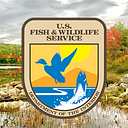Bog turtles — a One Health Ambassador
[caption id=”attachment_33842" align=”alignnone” width=”4000"]
A healthy bog turtle from a New York population. Credit: Sandy Doran, USFWS[/caption]
The One Health Initiative promotes the idea that human, animal, and environmental health are all linked, so by changing one aspect of the triad you inevitably affect the rest.
This initiative encourages collaboration across a variety of scientific disciplines to create synergist approaches to large scale health issues. Recent mortality events in populations of the country’s smallest turtle have provided an opportunity for the U.S. Fish and Wildlife Service to do just this — to bring together partners across a variety of disciplines to explore an issue that could be affecting more than the bog turtle.
Bog turtles, the smallest turtle in North America, are federally listed as a threatened species under the Endangered Species Act. Although these turtles are small they are mighty!
They have a lifespan of 30+ years and remain almost exclusively in the same wetlands where they hatched. They have become threatened primarily as a result of degradation, fragmentation and/or destruction of habitat, due to human activities.
In 2011, bog turtle populations in New York and Massachusetts had unexplained mortality events and individuals were showing clinical changes in their skin that included discoloration and ulceration.
[caption id=”attachment_33843" align=”alignnone” width=”3000"]
Biologist Sandy Doran holds a health bog turtle. Now you can really appreciate their small size! Credit: Sandy Doran, USFWS[/caption]
This puzzled many biologists and prompted a response to figure out what was causing the mortality. The U.S. Fish and Wildlife Service (USFWS) decided to fund a project involving Wildlife Conservation Society (WCS) veterinarians, pathologists and technicians, and state biologists to conduct health assessments on bog turtles at 4 sites in these two states.
Previous research on other turtle species suggested that infectious diseases, such as Mycoplasma (an upper respiratory tract disease), could be an important contributor to mortality.
WCS was unable to determine the actual cause of death, but the research did confirm the presence of Mycoplasma. Tests for ranavirus and herpesvirus came back negative.
Unfortunately, additional research efforts have had mixed results.
- Additional assessments in Dutchess County, New York, were negative for ranavirus as well as Mycoplasma, but were positive for herpesvirus.
- Data from New Jersey suggests that there is a high prevalence of herpesvirus in bog turtle populations in that state.
- Recent results from a 2017 study in Oswego County, New York, indicated that all the sampled bog turtles were healthy.
Ultimately the disease prevalence is highly variable and additional testing is required to understand the disease distribution within a variety of bog turtle populations. The 2017 study, funded by USFWS, allowed WCS and the State University of New York College at Oswego (SUNY Oswego) to assess turtles at a site that is far removed from other parts of the bog turtle range where positive disease detections have been made; it was of particular interest to better understand if bog turtles at this site carried the same diseases.
While there were some old injuries observed, and very occasional unexplained minor discoloration of skin, the sampled turtles were in very good condition.
Continuing to study this species is important because by better understanding these unexplained mortality events we can support a more robust wetland habitat system and ideally eventually recover this species (hooray!).
There are a lot of unknowns in this project like how climate change may play a role in bog turtle populations and whether a changing climate will trigger more disease impacts. The continuation of research efforts will allow more knowledge to be gained to help protect this species long term.
This collaborative effort remains on-going to protect this tiny turtle and to better understand the impacts to habitat and disease. The more we can encourage and work together toward common conservation goals the better we can promote and protect the biodiversity of our world, one tiny turtle at a time.

